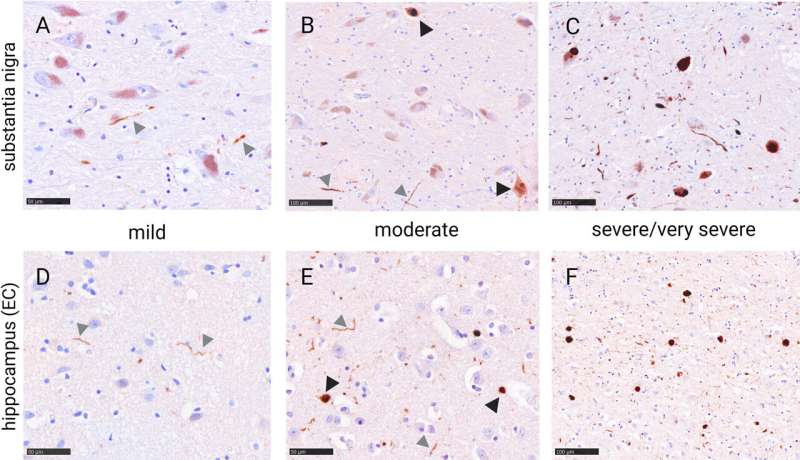Immunohistochemical staining with 5G4 antibody against alpha-synuclein in the Tampere Sudden Death Study cohort. Black arrowheads highlight LBs and gray arrowheads point to Lewy neurites. Credit: Annals of Neurology (2024). DOI: 10.1002/ana.26912
Lewy body disease may be more common in middle-aged people than previously thought, according to a recent study by the University of Helsinki and the University of Tampere. In the study, almost 1 in 10 of over-50-year-olds were found to have tissue markers of Lewy body disease in the brain.
Lewy body disease is the second most common brain degenerative disease after Alzheimer's disease. Lewy bodies, deposits of alpha-synuclein protein, are found in the brainstem, limbic system and cerebral cortex. Similar tissue changes are also seen in patients clinically diagnosed with Parkinson's disease.
Lewy body disease can be difficult to recognize at the beginning of the disease, as it progresses slowly. Symptoms often include movement disturbances, memory problems and psychiatric symptoms.
In their recent study, researchers from the Universities of Helsinki and Tampere investigated for the first time, the occurrence of Lewy body disease markers in young and middle-aged subjects who were not known to suffer from Lewy body or Parkinson's diseases. Previous similar studies have investigated the occurrence of the disease markers in people over 60 years old.
The researchers found that Lewy body disease changes may begin to develop in the brain already in middle age, even if there are no actual symptoms yet. The results have been published in the journal Annals of Neurology.
"Our findings indicate that Lewy body disease may be more common in people over 50 than previously thought. In the study, we found disease changes in 9% of people over 50 who did not have a clinical diagnosis of Parkinson's disease or Lewy body disease. However, further studies are needed to confirm the results," says Associate Professor Liisa Myllykangas from the University of Helsinki.
Earlier diagnosis means more effective treatment
In their study, the researchers used internationally unique Finnish forensic autopsy data, which consists of approximately 600 people aged 16–95 who died outside hospitals.
Myllykangas says that in the future the treatments developed against degenerative brain diseases will be aimed at patients who are in the early stages of the disease, or are at risk of developing the disease.
"Finding out the prevalence of disease changes in younger age groups is therefore important as this will be the most effective time to start therapies," she says.
More information: Eloise H Kok et al, Accumulation of Lewy‐Related Pathology Starts in Middle Age: The Tampere Sudden Death Study, Annals of Neurology (2024). DOI: 10.1002/ana.26912
Journal information: Annals of Neurology
Provided by University of Helsinki
























